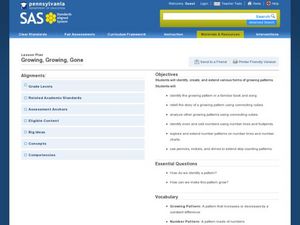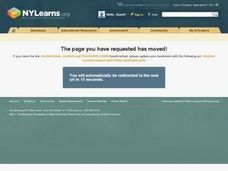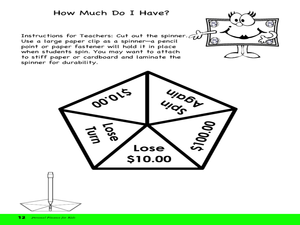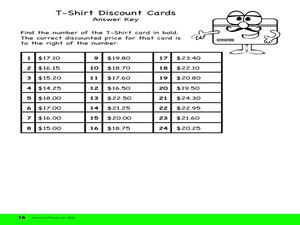Curated OER
Flipping Coins: Density as a Characteristic Property
Young scholars explore linear functions in a crime solving context. They collect and analyze data using linear equations, then interpret the slope and intercepts from a linear model.
Curated OER
Money & Work
Students explain basic information concerning financial investments. They identify consumer rights and responsibilities and effective practices for purchasing consumer goods, services, housing and insurance. They list steps in setting...
Curated OER
Using a Round-O-Meter to Estimate
Explore the concept of rounding numbers to the nearest dollar or dime. Youngsters use a "round-o-meter" to determine which direction to round a number. They make round-o-meters out of a piece of paper, a piece of string, and a paper clip.
Curated OER
A Mass of Pennies
Learners estimate and determine the number of cents (pennies) that are needed to equal the mass of a variety of common objects. They develop a process for measuring and explore concepts related to units of measurement.
Curriculum Corner
Guest Teacher Plans Grade 4
Creating substitute plans may not be the highlight of your workday. Make the task less daunting with a general, day-long plan covering math, reading, word work, and writing.
Baylor College
Calculating Exponential Growth
There can be a steep learning curve when teaching about exponential growth, but the lesson helps kids make sense out of the concept. When talking about exponential growth of viruses, learners may not be very interested, but when you are...
Curated OER
Variance and Covariance: How much to do baseball players really make?
Is baseball really the road to riches? Here, statisticians look at salary data from baseball players and use variance to measure the spread of the data to more accurately answer that question. Note: The salary data provided is from 1994,...
PBS
The Yo-Yo Problem
What do yo-yos and pennies have to do with linear equations? Learn about writing and solving linear equations while considering the Yo-Yo Problem and Penny Pattern Exploration from the High School Math Project. Learners utilize algebra...
Curated OER
Growing, Growing, Gone
Budding mathematicians identify growing patterns in numbers and songs then create their own patterns. They look at number patterns and language patterns and then create their own using money and footprints.
Curated OER
Problem Solving
Scholars will learn to solve word problems using addition, subtraction, multiplication or division. Using a grocery store theme, they will identify the best way to solve real-life problems. There are many ways this basic instructional...
Curated OER
The Nitty-Gritty of Checkbooks
Students explore how to maintain a checking account. They control, disburse money, and keep their checking account balance. Through a PowerPoint demonstration, video streaming and hands-on practice, students apply the information given...
Curated OER
Cost Effective Buying
Students evaluate energy-related purchases. In this consumer awareness lesson, students visit an appliance store and rank the products' cost effectiveness by using a mathematical formula.
Curated OER
Spelling Counts!
Play a game to practice spelling and math. By assigning a numerical value to each letter of the alphabet, you can engage learners in "spy" coding and decoding activities that reinforce grade-appropriate spelling and math skills....
Curated OER
Tick Around the Clock
Learners examine and discuss the differences between clocks they are shown. Using the internet, they research how people used to tell time before clocks. They review what the long and short hand on the clock represent and practice...
Curated OER
Penny Pushing
Fifth graders use an Excel spreadsheet to show them how to enter the amount of pennies they bring each week to school for a fundraising project. They count their pennies each Friday and enter the total amount in the correct columns. In...
Curated OER
Probability - Explore and Tabulate
Upper elementary and middle schoolers explore the concept of probability. In this probability lesson, pupils flip coins and draw chips out of a bag to determine the likelihood of a particular outcome. They perform the experiments with...
Curated OER
Savings and Budget
Second graders investigate the concept of developing a budget. In this financial awareness lesson, 2nd graders read the book The Case of the Shrunken Allowance and brainstorm ways they can save and budget money. Students create their own...
Curated OER
Wealth
Third graders read the story The Day I Was Rich and learn about the role of money and taxes. In this money lesson plan, 3rd graders count large sums of money, group them, and give it away in the form of taxes. They discuss wealth and how...
Curated OER
Wise Shoppers
Students complete several activities to learn about currency and the functions of money. For this money functions lesson, students complete activities to learn what are the functions of money. Students calculate item prices with...
Curated OER
Coupon Clippers: Understanding Comparative Shopping
Third graders participate in a shopping spree after listening to Pigs Go to Market: Fun with Math and Shopping. After the story is read aloud, 3rd graders answer discussion questions and review key vocabulary. Students complete provided...
Curated OER
Savings and Earnings
Fifth graders complete several activities to learn about earning, budgeting, and saving money. In this saving money lesson, 5th graders read a book about saving money and complete a 'Savings and Earnings' worksheet. Students work in...
Curated OER
Buckets of Bucks for World Hunger
Students participate in a nonprofit organization activity for hunger outreach problems. In this service project lesson plan, students practice counting coins, complete a service project for a hunger outreach, discuss nutrition and...
Curated OER
A Trip to the Toy Store
First graders recognize and identify the value of a penny, nickel and dime. They spend play money in a simulated toy store and match their coins to the purchase price of a toy of their choice.
Curated OER
Fraction Conversions
Students convert between fractions, decimals, and percents using money. In this conversions lesson plan, students play with a mock store in class.

























